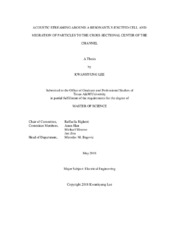| dc.contributor.advisor | Righetti, Raffaella | |
| dc.creator | Lee, Kwanhyung | |
| dc.date.accessioned | 2019-01-17T17:15:34Z | |
| dc.date.available | 2019-01-17T17:15:34Z | |
| dc.date.created | 2018-05 | |
| dc.date.issued | 2018-04-24 | |
| dc.date.submitted | May 2018 | |
| dc.identifier.uri | https://hdl.handle.net/1969.1/173392 | |
| dc.description.abstract | Recently, a theoretical method was proposed to efficiently and accurately predict acoustic streaming around a resonantly-excited human cancer cell. The model also predicted that microparticles around the cell could be circulating along the acoustic streaming lines. The availability of this theoretical model allows determination of the resonance frequencies of the cell. In addition, the identified resonance frequencies are expected to be correlated with the mechanical properties of the cell such as density and compressibility.
The main focus of this work is the experimental corroboration of the previously proposed theoretical model. Validation of the theoretical model was performed by measuring and analyzing the acoustic streaming around MCF-7 breast cancer cells. For these experiments, a microfluidic device was fabricated using a photolithography technique, and cancer cells cultured with a sub-culturing process were used. The cancer cells and 2 µm Carboxylate microparticles suspended in the cell culture medium were injected into the microfluidic device. The device was then excited by a piezoelectric actuator with a sine wave in the frequency range of 20 kHz to 130 kHz. A resonance frequency range of 28.7 kHz to 42.0 kHz was measured experimentally when the microparticles were in circulatory motion around a cancer cell. The predicted resonance frequency range from simulations of the theoretical model was 28.665 kHz to 38.98 kHz, which is in good agreement with the experimental results. The slight underestimation of the theory with respect to the experiments may be due to small deviations of the cell modeling parameters. In this work, observations related to the migration of particles to the cross-sectional center of rectangular microfluidic channel are reported. The migration is necessary in order to make all particles to flow in same velocity. For this experiment, two different acoustic wave frequencies were investigated to generate both vertical nodal line and levitation forces to microparticles/cells in the channel. This would allow the experiment setting to be more similar to the simulation setting, leading to more accurate experiment result. | en |
| dc.format.mimetype | application/pdf | |
| dc.language.iso | en | |
| dc.subject | resonance frequency | en |
| dc.subject | PDMS-Silicon Microfluidic Devic | en |
| dc.subject | MCF-7 | en |
| dc.title | Acoustic Streaming Around a Resonantly-Excited Cell and Migration of Particles to the Cross-Sectional Center of the Channel | en |
| dc.type | Thesis | en |
| thesis.degree.department | Electrical and Computer Engineering | en |
| thesis.degree.discipline | Electrical Engineering | en |
| thesis.degree.grantor | Texas A & M University | en |
| thesis.degree.name | Master of Science | en |
| thesis.degree.level | Masters | en |
| dc.contributor.committeeMember | Han, Arum | |
| dc.contributor.committeeMember | Moreno, Michael | |
| dc.contributor.committeeMember | Zou, Jun | |
| dc.type.material | text | en |
| dc.date.updated | 2019-01-17T17:15:35Z | |
| local.etdauthor.orcid | 0000-0002-5824-5022 | |


